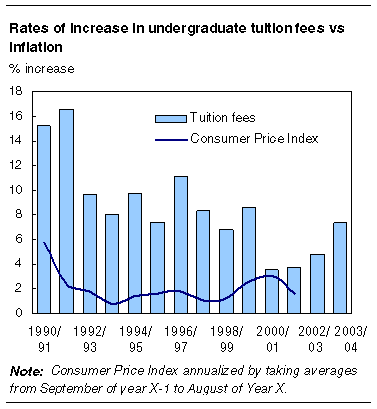D - so we see that tuition fees CONSISTENTLY exceed the rate of inflation - usually by a wide margin. Young adult students have become the piggy bank that is smashed open for extra change every time the Boomer - backed government feels a bit pinched. THIS is why the Quebec students are protesting - do you really think Charest's tuition hikes is a one-time thing? The students in Quebec saw what happened - and is STILL happening - in the rest of Canada! They've learned.
----------
http://www.statcan.gc.ca/daily-quotidien/100916/dq100916a-eng.htm
http://goodcanadiankid.com/40-000-receipt-tuition-students-paying/
But let’s get to the bottom line: how much tuition should students be paying? How much should I be paying for my Bachelor of Science? I think to answer that question, we need to look at the benefits of a university education. Let’s go back to the metaphor of the business. When a university educates a student, everybody wins. I get an education in something specific, and Ontario gets an educated worker. It might not sound like that big of a deal, but it is projected that in coming years, 7 out of 10 new jobs will require a PSE credential.
----------
D - at some point, accepting a student loan debt to fund a post-secondary education will CEASE TO MAKE SENSE. Do we really want our young adults spending their 20s alternating between unskilled jobs and school (possibly part-time) just so they can get a college diploma/ U degree that is only, via credentialism, "the new high school"?
Additional compulsory fees on the rise
The bundle of services included in additional compulsory fees varies from one institution to the next and can change over time. Typically, it includes fees for athletics, student health services, student associations, as well as other fees that apply to full-time Canadian students.
Starting this year, "partial" compulsory fees such as health plan and dental plan fees that students can choose not to pay if they provide proof of comparable coverage are not included in the calculation of the weighted average for compulsory fees.
Nationally, additional compulsory fees for Canadian undergraduate students increased 7.0% in 2010/2011 compared with the previous year. On average, these students paid $702 in additional compulsory fees in 2010/2011, up from $656 a year earlier.
In 2010/2011, additional compulsory fees for undergraduate students ranged from $407 in New Brunswick to $818 in Alberta. Compulsory fees for graduate students ranged from $234 in Saskatchewan to $984 in Newfoundland and Labrador.
Alberta posted the largest increase in additional compulsory fees for both undergraduate (+$183 or +28.8%) and graduate (+$166 or +24.4%) students. In contrast, compulsory fees decreased in two provinces: New Brunswick (-0.7%) and British Columbia (-12.0%).
Additional compulsory fees are generally excluded from fee regulations and are normally determined in part by provincial departments, institutions and student organizations.
-----------
D - the Quebec students watched what Bob Rae next door in Ontario did in the 1990s. But the tuition hikes NEVER stopped. They continue far about the inflation rate. In fact, considering COMPULSORY FEES also, they are increasing at a rate even higher than tuition charts would suggest!
------------
D - tuition should have REMAINED at c. 10% of operating costs - and gov't contributions should have remained at c. 75%.
Notice anything? The last latest Boomers were born 1964. Allowing for age 21 at graduation, they were all done university as of ... 1985. For the latest Boomers, gov't contributions had decreased- but tuitions remained steady. The universities took the hit and soaked the loss - until the Boomer were finished. Around 1990, they realized they were neglecting long-term operating costs, and tuitions went up.
AFTER all the Boomers were finished with school - including grad school.
Once again, my "benign neglect hypothesis" holds up stellarly well in explaining Boomer behavior. I don't wish to engage in paranoid "patriarchy theory" conspiracy theories such as feminism espoused. I don't need the Boomers to act collectively like a moustachio-twirling villain for my hypothesis to be valid. I just require that they act selfishly regarding gov't policy of funding and taxation at every stage of their life. And THAT they have demonstrably done!
----------
http://www.ousa.ca/2011/11/24/how-important-are-ancillary-fees-by-chris-martin/ (D - nice summary!)
Even the names associated with these fees paints a picture of relative unimportance; they’re “incidental,” “ancillary” or “miscellaneous.”
Students find this to be an unfortunate reality, since ancillary fees are growing steadily both in terms of cost to students and in their importance to university finance. These fees pay for a wide variety of non-academic services, including health insurance plans, public transit, athletic centres, physical and mental health services, student governments, food banks, campus construction projects and more. After accounting for inflation, ancillary fees per student have grown by six times since 1980, doubling the rate of growth in tuition fees over the same period. This has obviously meant that students are paying more ancillary fees than they ever have before. According to Statistics Canada, Ontario has the second highest average ancillary fees in the country, making our province the most expensive in Canada in which to attend university by nearly $1,000.
Ancillary fee revenue for each full-time equivalent student has increased from approximately $136 in 1979-80 to over $966 in 2009-10, accounting for more than one-seventh of the average student’s bill. In terms of importance to the overall university system, ancillary fee revenue has grown on average from less than one per cent of the operating budget to over six per cent during the same time period. In 2011-12, combined ancillary fee and tuition revenue pushed the overall student contribution to Ontario university operating budgets to 47.96 per cent, just below the government’s contribution of 48 per cent. This means that for the first time, Ontario students are now contributing just as much to the operating costs of universities as the provincial government.





No comments:
Post a Comment